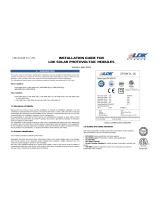
4JA SOLAR INSTALLATION MANUAL 5JA SOLAR INSTALLATION MANUAL
3.1 Product Identification
3.2 Conventional Safety
3.3 Electrical Performance Safety
GENERALGENERAL
Each module has three labels providing the following information:
1. Nameplate: describes the product type; Peak power, Max. power current, Max. power
voltage, open circuit voltage, short circuit current, all as measured under standard test
conditions; Certification marks, the maximum system voltage etc.
2. Current Sorting: According to the Max. power current, Modules are sorted into three
classes: H,M or L(H means the highest current). And the class is marked as a symbol
"Current class X" on the backsheet of the Modules. To get optimal performance of
Modules, it is recommended to connect the Modules with the same class in a string.
3. Barcode: each individual Module has a unique serial number. The serial number has
15 digits. The 1st and the 2nd digits are the year code, and the 3rd is the month code.
For example, 121PXXXXXXXXXXX means the Module was assembled and tested in the
January of 2012. It is permanently attached to the interior of the Modules and is visible
from the top front of the Module. This barcode is inserted prior to laminating. In addition,
you can find a same barcode beside the nameplate.
JA Solar Modules are designed to meet the requirements of IEC 61215 and IEC 61730,
application class A. Modules rated for use in this application class may be used in system
operating at greater than 50V DC or 240W, where general contact access is anticipated.
Modules qualified for safety through IEC 61730-1 and IEC 61730-2 and within this
application class are considered to meet the requirements for safety class II equipments.
When Modules are mounted on rooftops, the roof must have a fire resistant covering
suitable for this application. Rooftop PV systems should only be installed on rooftop that
is capable of handling the additional weighted load of PV system components, including
Modules, by a certified building specialist or engineer and have a formal structure of the
complete analysis result.
For your safety, do not attempt to work on a rooftop until safety precautions have been
identified and taken including without limitation fall protection measures, ladders or
stairways, and personal protective equipment.
For your safety, do not install or handle Modules under adverse conditions, including
without limitation strong or gusty winds, and wet or frosted roof surfaces.
Photovoltaic Modules can produce DC electricity when exposed to light and therefore can
produce an electrical shock or burn. DC voltage of 30 Volts or higher is potentially lethal.
Modules produce voltage even when not connected to an electrical circuit or load. Please
use insulated tools and rubber gloves when working with Modules in sunlight.
Modules have no on/off switch. Modules can be rendered inoperative only by removing
them from sunlight, or by fully covering their front surface with cloth, cardboard, or other
completely opaque material, or by working with Modules face down on a smooth, flat
surface.
In order to avoid arcs and electrical shock, please do not disconnect electrical connections
under load. Faulty connections can also result in arcs and electrical shock. So please keep
connectors dry and clean, and ensure that they are in proper working condition. Never
insert metal objects into the connector, or modify them in any way in order to secure an
electrical connection.
Reflection from snow or water can increase sunlight and therefore boost current and power.
In addition, colder temperatures can substantially increase voltage and power.
If the glass or other material is damaged, please wear personal protection equipment and
separated the Modules from the circuit.
Do not touch the Modules if they are wet, unless during the cleaning procedure. If you need
to clean the modules, please follow the cleaning requirements mentioned in the manual.


















